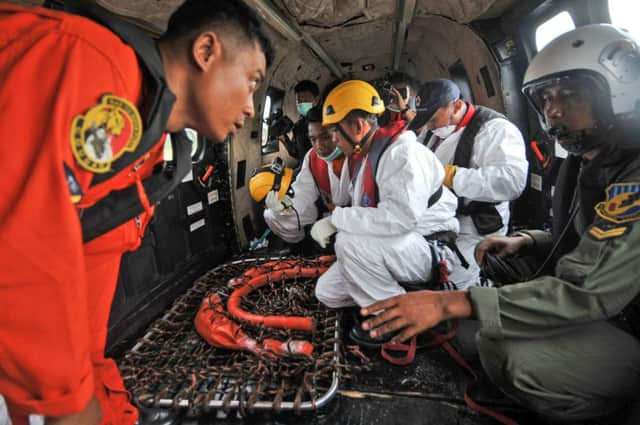Search area spreads for wreckage of AirAsia plane


Despite the bad weather, search teams did manage to find two new metal objects but there is still no sign of the crucial black box flight recorders.
Flight QZ8501 plunged into the water off Borneo island on 28 December, about 40 minutes into a two-hour flight from Indonesia’s second-biggest city of Surabaya to Singapore. There were no survivors among the 162 people on board.
Advertisement
Hide AdAdvertisement
Hide AdSo far just 39 bodies have been recovered and there are also concerns it will become harder to find the remaining victims. Jakarta has launched a crackdown on its fast-growing aviation sector since the crash, reassigning some officials and tightening rules on pre-flight procedures in a country with a patchy reputation for air safety.
“Time is of the essence,” said the National Search and Rescue Agency’s director of operation, Suryadi B Supriyadi. “But it seems like it is hard to beat the weather.”
“Divers were ready on the ship but the challenges were currents and waves,” the head of Indonesia’s search and rescue agency, Fransiskus Bambang Soelistyo, told a news conference in Jakarta last night.
He said a US navy ship located two more metal objects using sonar, but it is not known if they are part of the missing plane. Those would add to the five large objects, believed to be parts of the plane, detected so far. Two more bodies were also recovered from the sea, bringing the total found so far to 39.
CONNECT WITH THE SCOTSMAN
• Subscribe to our daily newsletter (requires registration) and get the latest news, sport and business headlines delivered to your inbox every morning
Search and rescue agency official Mr Supriyadi, who is coordinating the operation, said there had been no “pings” detected from the black box’s emergency locator beacon, possibly because it was buried in the seabed or the muddy water was impeding its signal. “They haven’t found anything, maybe because the water is turbid and there is zero visibility,” he said. “There’s a possibility it is buried in mud.”
The captain of an Indonesian navy patrol vessel said on Monday his ship had found what was believed to be the tail, a key find since that section of the aircraft houses the cockpit voice and flight data recorders.
But Mr Soelistyo said that could not yet be confirmed. The batteries in the pingers on the black boxes are likely to die in about 20 days.
Advertisement
Hide AdAdvertisement
Hide AdFewer than a third of the bodies of the mostly Indonesian passengers and crew have been recovered so far. Many more could still be trapped in the fuselage of the aircraft.
Indonesia has suffered a string of accidents in recent years. It deregulated its aviation industry in the 1990s, and dozens of new carriers have made air travel affordable for the first time for many in the world’s fourth-most populous nation.
Experts say poor maintenance, rule-bending and a shortage of trained personnel are largely to blame. Infrastructure has also failed to keep pace with demand.
The country’s transportation ministry launched a crackdown on Monday after it was found Flight 8501 had no permit to fly between Surabaya in Indonesia and Singapore on the day of the crash.
All AirAsia flights on that route have been cancelled, pending an investigation.
It is not known what caused the Airbus A320 to crash into the Java Sea 42 minutes after take-off, although Indonesia’s weather agency said bad weather appears to have been a factor.
Just before losing contact, the pilot told air traffic control he was approaching threatening clouds, but was denied permission to climb to a higher altitude because of heavy air traffic. No distress signal was issued.
SCOTSMAN TABLET AND IPHONE APPS